Slowtwitch Mailbag – 1
This is our first edition of the revived and revamped Slowtwitch Mailbag. For full details on how it works, please click HERE.
Here is the short version:
While our previous Mailbag column centered around all-things-electronics (GPS devices, heart rate monitors, iPhone apps, and the like), the new version accepts any and all triathlon-related tech questions.
Your questions will be answered by the ‘Slowtwitch Braintrust’ – our staff of editors, contributors, and friends. Whoever is most qualified to answer your question will do so. We will consult with manufacturers and outside experts whenever possible and applicable.
How do you go about submitting a question? Send an email to: Mailbag (at) Slowtwitch (dot) com. Yes, type it out like a normal email address.
We will publish Mailbag responses every 1-2 weeks.
—
Let’s get to the questions for this week!
#1: Harvey asks, “I’m competing for a 70.3 worlds slot. Ride with or without a spare bag, asks the weight weenie?”
By ‘spare bag’, we take it that you mean some sort of repair kit. This one is a fairly simple question, so you’re stuck with the lowly Slowtwitch Tech Editor (me) to answer.
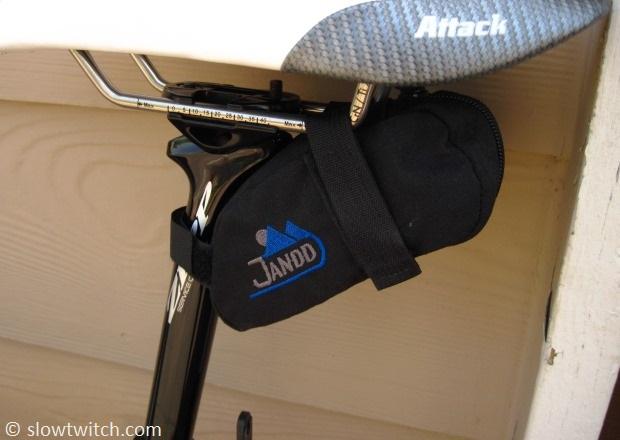
It really comes down to a few things:
1. How much risk you’re willing to deal with
2. How much reward you think you’re going to get
3. Your tire choice and whether or not you use sealant in those tires
4. Your experience changing flat tires
5. Your bike setup and easy-of-carry of such items
I’ll knock these out in order. First, risk and reward. The risk part is up to you. Would you rather risk not finishing for a potential reward of a little speed? How much speed do you think you’re gaining by losing the saddle bag? If the course on which you hope to qualify is flat-as-a-pancake, there is little-to-no advantage to riding sans saddle bag. If it’s super-duper hilly, weight does come in to play a little more. I honestly don’t know of anyone who has done a tightly controlled and accurately measured test of saddle bags’ effect on cycling speed on various courses, so it’s hard to give exact numbers.
Your tire choice plays hugely into this as well. If you’re riding Continental Competition tubulars with two ounces of thick sealant in each tire, your chance of a flat tire is MUCH less than a paper-thin track tire sans sealant. No tire is flat-proof, but they certainly are not all created equal in this regard.
Are you experienced changing tires? Do you have race wheels? Are they tubulars or clinchers? With tubular tires, the weight and aero penalty is higher for carrying a spare. It should also go without saying that if you don’t know how to change a tubular tire on the side of the road, you may as well not carry a spare (although I’d never recommend riding tubulars without having practiced changing tires at least a couple times). If you puncture and can’t change it, you’re waiting for tech support regardless of what you carry.
Last, how is your bike set up in terms of hydration and race number placement? If your frame only has one bottle cage and you don’t like having a bottle between your arms, that means that one is likely going behind your saddle (meaning that you cannot use a traditional saddle bag). If this is the case, many folks will use a double bottle holder, and use one of them for a repair kit. I’ve done this by cutting the top off of a bottle, stuffing my tube and tools inside, and putting a few pieces of electrical tape over the top.
Personally, I almost always race with a repair kit. My current bike does not require that any bottles or accessories be placed behind the saddle, so I use a mini bag (my Jandd bag is pictured above).
Inside, I’ll carry the following:
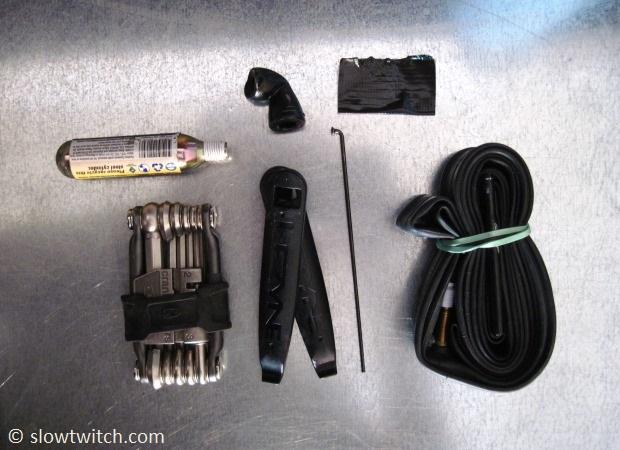
-Mini inflator (I like the really short ones that require threaded C02 cartridges because they work with ALL wheels, including discs).
-C02 cartridge
–Short valve tube with lots of Teflon tape pre-applied (so it will seal with a valve extender)
-Long valve extender that will work on any depth of wheel I’ll ride
-Multi tool
-Tire levers
-Tire boot made from duct tape
-A ~4-inch length of spoke that can be used to purge air from valve extenders
For long-course races, I’ll also carry a spare chain master link
I’d simply go with what your gut is telling you. If you’re going to feel faster without the bag, ride without the bag. If you’re going to worry about flat tires the whole race, use the bag. Chrissie Wellington showed us that – with a little help from our friends – a high level of racing success is possible even with a flat tire.
#2: Jon asks, “I nicked the paint on my bike. Both the clear coat and the paint came off. There is now naked carbon exposed. It is not a very large area; just a few millimeters in diameter. What is the best way to cover the exposed carbon?”
So you had something like this happen?
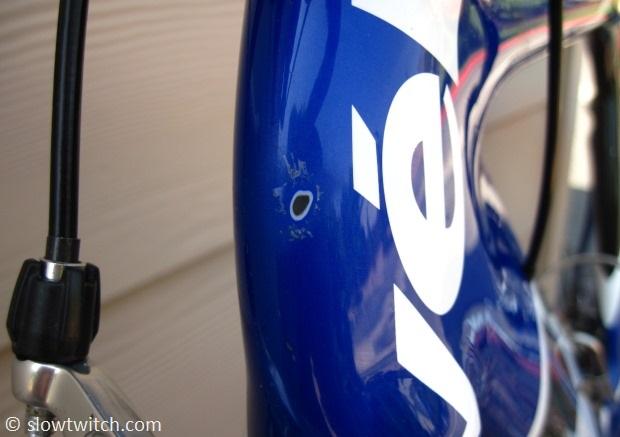
While it is a cosmetic bummer, there probably isn’t a risk for structural damage. My first gut response was to just treat it like an aluminum frame – paint over the scuff with touch-up paint or clear nail polish. Similar to using solvents on exposed carbon, you just want to use something that doesn’t attack epoxy resin.
The other option is to just leave it alone. On my personal carbon bikes, I’ve never had a scratch that was deep enough that I really cared to do anything. It’s not going to corrode, and exposure to the air isn’t going to hurt it.
Just to be double sure, I inquired with Damon Rinard of Cervelo. He passed my question along to Don Guichard, who heads up their Project California. Don responded:
“No issues with ultraviolet exposure or moisture absorption. Regarding solvents, don't use anything you wouldn't want to use on the paint surface and you'll be fine.”
There you go. Sounds like the solution is to go give that bike a workout of a few thousand pedal strokes. The post-workout endorphins running through its carbon weave will surely make it forgive you for the scratch.
#3: Tijmen asks, “If I am not mistaken, we are allowed to use a front disc wheel in triathlon. We all know the images of the TFD rider falling due to a big gust of wind. But recently, in the 2012 Olympic women’s time trial race, I saw a competitor using a front disc. So that brings me to the question: Why don't we see front discs used more often in triathlons? I guess it would be very aerodynamic, and could be used on days with not too much wind.”
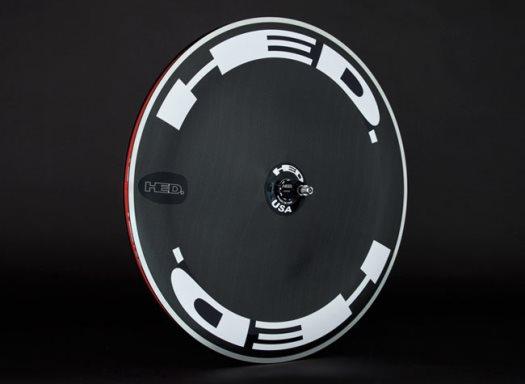
Above image © Hed
Great question. Many of us have used a rear disc wheel, so why not a front? To find out more, I inquired with Andy Tetmeyer of Hed Cycling:
“I have not personally ridden a front disc – indoors or out, but I have talked with a couple guys who have ridden them outside in TTs. They told me that they were very hard to handle, even on a calm day. I recall once at the state TT, a past winner showed up with a front Wolber disc. We had excellent conditions that day, the course was a simple out and back. I think the guy came 5th or 6th that day, and he said the bike was hard to handle even in pretty calm conditions. Granted, this was a flat Wolber disc. I would expect it to handle poorly, but this particular rider was no slouch; he was an excellent crit rider with good handling skills. To my knowledge he only used the front disc once.
They're not impossible to ride. One of the employees here rides a front disc on his upright three-speed occasionally. If you are willing to ride pretty upright at moderate speed on a very slack bike, then a front disc is not a death sentence on a calm day. It certainly makes a three-speed faster. However, race speed on a race bike is very far removed from an occasional commute on [an upright bike]. Low speed is important here because even on the bike in question, the handling is noticeably affected by the wind. At higher speed if you are suddenly blown off your line you will go MUCH further off at 25 or 30mph than you will at 12 or even 18mph.
Shara Gillow did ride a front disc at the Olympics, and the came 13th, 2:50 off the winning time. It could have been a bad day, could have been that all things considered, a front disc is not faster outdoors.
With all this discussion, now I think I'll take Sean's bike around the block next time he rides it in. Even so, I am not tempted in the slightest to try to race a front disc outside.”
Andy’s comments echo what I’ve heard from other riders – the handling implications make the risk outweigh the reward in most cases. The deepest wheel I’ve ridden is a 108mm-deep Zipp 1080, and I found it to be plenty of wheel for me on the front. Especially for triathlon (and not time trial), we really have to consider fatigue of our neck, shoulder, and trunk muscles. I don’t know too many folks that do regular swim-bike brick workouts – but that’s what you do on race day (and at your hardest effort).





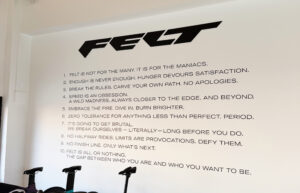
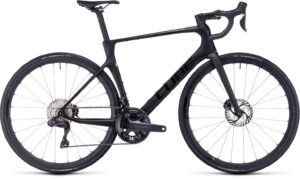

Start the discussion at forum.slowtwitch.com